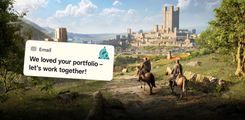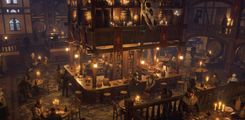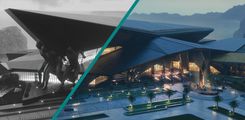Table of Contents
- Kicking off
- Reference Gathering & Moodboarding
- Sketch Phase: Thumbnails & Silhouettes
- Detailing & Rendering
- Final Presentation
- Final Thoughts
Concept Art Process for a Military FPS Vehicle
Go behind the scenes of our Casino Chaos project as we design a military Light Utility Vehicle - built for gameplay, grounded in realism, and ready for action!
Concept art is more than just creating visually striking environments or memorable characters. In video games, everything from environments and props to characters must be intentionally designed. Every element must align with the game’s mechanics, setting, and tone.
Even vehicle design must match the aesthetic and narrative of the game. For example, in a first-person shooter, a vehicle that visually suggests firepower (like visible side-mounted guns) should behave accordingly in-game. If it doesn't, the disconnect can confuse players. Simply put: form follows function.
Vehicles also tell their own story. Their design should reflect the game’s era and genre whether sci-fi, modern-day, or retro and even signal faction ownership through consistent shape language and visual motifs.
In this blog, we’ll walk you through our process of designing a military-grade Light Utility Vehicle (LUV) for Casino Chaos, our modern FPS game project.
You can also watch our full walkthrough of our Casino Chaos environment on our YouTube channel.
Kicking off
From previous concept work on our Casino Chaos project, we established a modern-day setting with a brutalist architectural style. We chose a design language that is all sharp angles, rigid forms, and functional shapes which influences every element, including vehicles. We avoided sci-fi elements to maintain consistency and immersion in the world we have built so far.
We defined our vehicle’s role early on: a Light Utility Vehicle (LUV) capable of both on-road and off-road travel. It’s faster than heavier military transports, with light armor for mobility, and rugged enough for ramming without sacrificing speed or handling.
A Jeep-like four-wheel drive vehicle for military use—lighter than standard military trucks, compact, often lightly armored, and built for agile, all-terrain mobility with around four-passenger capacity.
We also had to consider whether this design would serve as a base model for upgrades or variants and ensure it could support cosmetic skins without compromising its tactical realism.
Reference Gathering & Moodboarding
Every project at our concept art studio begins with a brief. The brief serves as a guide for our art team, helping to communicate ideas, define parameters, and highlight potential challenges.
We gather references from real-world military vehicles, along with our previous work on Casino Chaos, to better understand and maintain the established design language.
We also consult military hardware catalogues and genre-defining video games like Battlefield and Call of Duty to gain insights into gameplay functionality and practical design considerations.
Each reference is selected with intention - whether for its form, level of detail, or functional elements - to inspire and inform our design decisions. Once we’ve gathered these references -whether sourced by the artist or provided by the client we begin the creative process.

We gather references from real-world military vehicles.
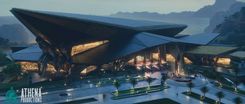
One of our many environments from Casino Chaos where we used brutalist shapes and architecture.
Sketch Phase: Thumbnails & Silhouettes
We started with silhouette sketches to focus on shape and readability. At this early stage, speed and variety are more important than detail. Working loosely allows for quick iteration and your first idea is rarely your best.
We explored a wide range of shapes while staying true to the brutalist, utilitarian language that we have established.
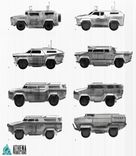
Once we had a variety, we selected three promising options and refined them with new angles to better understand their 3D form.
Using basic 3D blockouts combined with 2D paintovers, we can use a fast workflow to maintain perspective accuracy and iterate efficiently.
From there, we selected the final design and refined the front of the vehicle, balancing the aggressive look needed for ramming with practical concerns like engine ventilation. Believability was key - if the vehicle looked too enclosed, it might feel unrealistic.
Feedback loops from both teammates and clients plays a vital role throughout the early iteration phase.

Once we had a variety, we selected three promising options and refined them with new angles to better understand their 3D form.

From there, we selected the final design and refined the front of the vehicle, balancing the aggressive look needed for ramming with practical concerns like engine ventilation.
Detailing & Rendering
Now that we’ve settled on a direction for our military LUV, we move into the 3D phase. In this case, we use Blender to model the hard surface of the vehicle. This method is more efficient for our team, who are well-versed in a 3D pipeline for concept art. Since we know we’ll eventually need a full turnaround sheet of the vehicle from all angles, working in 3D from the outset helps save time later in the process.
With that end goal in mind, we design the vehicle from every angle to ensure consistency in the visual language across all views. As we refine the model, we make key design decisions such as the placement of light armor, weapon mount positions, and how the wheels and wheel arches are configured to enhance protection and mobility. At this stage, we begin focusing on smaller details that reinforce the vehicle’s function and communicate its purpose clearly to the viewer.
We opted for wide tracks and a low center of gravity to evoke a sense of stability and power. The vehicle’s color scheme remains intentionally plain at this point, with only subtle variations in the pattern. We deliberately avoid using rust or excessive wear, as we want the LUV to appear as a well-maintained military asset rather than a scavenged or improvised machine.
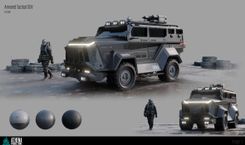
Final Presentation
The final concept presentation is aimed at 3D artists. It must communicate every necessary detail for modeling and texturing.
We produced a full turnaround, showing:
- Front
- Rear
- Side views
- Top-down
- Three-quarter angle
Lighting was balanced to reveal form without losing detail in harsh shadows. We also indicated material finishes such as matte vs. glossy so that texture artists could replicate the look accurately.
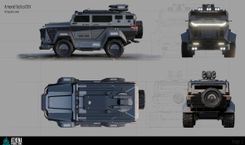
After approval, we moved on to designing skins. These cosmetic variations explore different color schemes and decals, showing the vehicle’s adaptability across contexts without looking cartoonish or gimmicky.
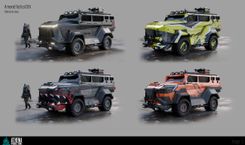
Final Thoughts
Designing a military LUV for a modern FPS isn’t just about making something that looks “cool.” It’s about crafting a vehicle that serves gameplay, supports narrative, fits the world, and can be produced by a 3D team with confidence.
From the earliest thumbnail to the final render, every line, bolt, and panel has a purpose. Remember always: form follows function!
If you’re looking to create awesome vehicles, our concept art studio Athena Productions is ready to bring your vision to life with exceptional design, functionality and storytelling. Discover how our team can help today!

